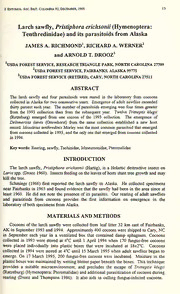
Larch sawfly, Pristiphora erichsonii (Hymenoptera: Tenthredinidae) and its parasitoids from Alaska PDF
Preview Larch sawfly, Pristiphora erichsonii (Hymenoptera: Tenthredinidae) and its parasitoids from Alaska
J.ENTOMOL.SOC.BRIT.COLUMBIA92,DECEMBER, 1995 25 Larch sawfly, Pristiphora erichsonii (Hymenoptera: Tenthredinidae) and its parasitoids from Alaska JAMES A. RICHMOND', RICHARD A. WERNER' and ARNOLD T. DROOZ^ ^USDAFORESTSERVICE, RESEARCHTRIANGLEPARK, NORTHCAROLINA27709 'USDAFORESTSERVICE, FAIRBANKS, ALASKA 99775 ^USDA FORESTSERVICE (RETIRED), CARY, NORTH CAROLINA27511 ABSTRACT The larch sawfly and four parasitoids were reared in the laboratory from cocoons collected in Alaska for two consecutive years. Emergence ofadult sawflies exceeded thirty percent each year. The number ofparasitoids emerging was four times greater from the 1993 collection than from the subsequent year. Twelve Tritneptis klugii (Ratzeburg) emerged from one cocoon of the 1993 collection. The emergence of Delomerista laevis (Gravehorst) from the same collection established a new host record. Mesoleius tenthredinis Morley was the most common parasitoid that emerged from cocoons collected in 1993, and the only one that emerged from cocoons collected in 1994. Keywords: Rearing, sawfly,Tachinidae, Ichneumonidae, Pteromalidae INTRODUCTION The larch sawfly, Pristiphora erichsonii (Hartig), is a Holartic destructive insect on Larixspp. (Drooz I960). Insectsfeedingonthe leaves ofhosts stunt tree growth and may kill thetree. Schmiege (1966) first reported the larch sawfly in Alaska. He collected specimens near Fairbanks in 1965 and found evidence that the sawfly had been in the area since at least 1960. He did not note the presence ofits parasites. Our rearing ofadult sawflies and parasitiods from cocoons provides the first information on emergence in the laboratory ofboth specimensfrom Alaska. MATERIALS AND METHODS Cocoons ofthe larch sawfly were collected from leaf litter 32 km east ofFairbanks, AK in September 1993 and 1994. Approximately 400 cocoons were shipped to Gary, NC in September each year in a ventilated box that contained damp sphagnum. Cocoons collected in 1993 were stored at 4°C until 1 April 1994 when 170 frmgus-free cocoons were placed individually into plastic boxes that were incubated at 18±2''C. Cocoons collected in 1994 were stored at 4°C until 15 March 1995 when adult sawflies began to emerge. On 17 March 1995, 200 fungus-free cocoons were incubated. Moisture in the plastic boxes was maintained by wetting blotter paper beneath the boxes. This technique provides a suitable microenvironment, and precludes the escape of Tritneptis klugii (Ratzeburg) (Hymenoptera: Pteromalidae) and additional parasitization ofcocoons during rearing (Drooz and Thompson 1986). It also aids in culling ftingus-infected cocoons. 26 J.ENTOMOL.SOC.BRIT.COLUMBIA,92DECEMBER, 1995 Data on the emergence of sawflies and parasitoids were recorded. Parasitiods were identified and voucher specimens deposited at the USDA Systematic Entomology Laboratory, Beltsville, MD. 4/114/t3404 4/1*4/204/21 4/33</3S4/3S4/36«/3a4/3S t/2 S/4 S/S E/* S/11S/l3B/13 Date Date Figure 1. Numberand cumulative percent oflarch sawflies, Pristiphora erichsonii and parasitoids reared in 1994 and 1995 in the laboratory from cocoons collected in September 1993 and 1994 in Alaska. . J.ENTOMOL. SOC.BRIT.COLUMBIA92,DECEMBER, 1995 27 RESULTS AND DISCUSSION During laboratory rearing 74 adult sawflies and 30 adult parasitoids emerged from the 1993 collection, and 122 sawflies and 7 parasitiods emerged from the 1994 collection (Fig 1). For the 1994 rearing, larch sawflies began emerging 14 days after incubation began and continued for about 1 month. Most sawflies emerged between the second and third week, at which time parasitoids also started to emerge. The start ofparasitoid emergence is similar to that seen when rearing Olesicampe benefactor Hinz (Hymenoptera: Ichneumonidae), a common parasite ofthe larch sawfly (Droozand Thompson 1986). Of the 30 parasitoids that emerged from the 1994 rearing, 2 were Bessa harveyi (Townsend) (Diptera: Tachinidae); 14 were Mesoleius tenthredinis Morley (Hymenoptera: Ichneumonidae); 2 were Delomerista laevis (Gravenhorst) (Hymenoptera: Ichneumonidae); and 12 were T. klugii_that emerged from one cocoon on 6 May. Almost all B. harveyi, T. klugii, andM. tenthredinis emerged after the peak ofhost emergence. D. laevis, a newhost record, emerged on 9 May, after most ofthe hosts. For the 1995 rearing, 10 adult sawflies emerged at 4°C on March 15 and 16 before cocoons were incubated (Fig. 1). After 200 cocoons were incubated on March 17, an additional 112 sawflies and 7 parasitoids also emerged. All ofthe parasitioids were tenthredinis. Peak emergence ofsawflies occurred between April 3 and 10, earlier than peak emergenceforthe 1994 rearing. The larch sawfly in Alaska is host to parasites native to Alaska and to one previously found only in other areas of North America. B. harveyi, D. laevis, and T. klugii are native parasites thatattackacross families ofsawflies. In contrast, M. tenthredinis, a host specific parasitoid, was introduced into Canada from England in 1910 (Hewitt 1912). Subsequent releases were made in eastern and central Canada (Criddle 1928), and it was released in southeastern British Columbia in 1934 (Hopping et al. 1943). It was never released in Alaska, and we suggest it arrived there with the northwestern migration ofits onlyknown host, the larch sawfly. ACKNOWLEDGEMENTS Specimens were identified by N. E. Woodley (Tachinidae), R. W. Carlson (Ichneumonidae), and D. R. Smith (Tenthredinidae) of the Systematic Entomology Laboratory, U. S. D. A., Beltsville, MD. We thank David R. Smith, Lynne C. Thompson and Michael R. Wagner for comments and suggestions. We appreciate the assistance of Jamie S. Godfrey and Christopher A. Gravesforpreparing the graphs. REFERENCES Criddle, N. 1928. The introduction and establishment of larch sawfly parasites, Mesoleius tenthredinis Morley, intosouthern Manitoba. Can. Entomol.60: 51-53. Drooz,A. T. 1960. Thelarch sawfly: ItsbiologyandControl. USDAFor. Serv., Tech. Bull. 1212: 1-51 Drooz, A. T. and L. C. Thompson. 1986. Collecting, rearing, shipping, and monitoring Olesicampe benefactor (Hymenoptera: Ichneumonidae), parasites of the larch sawfly, Pristiphora erichsonii (Hymenoptera: Tenthredinidae). GreatLakesEnt. 19: 181-184. Hewitt, C. G. 1912. Thelargelarch sawfly{Seniatuserichsonii). Can. Dept. Agric. Entomol. Bull. 5: 1-42. Hopping, G.R., H. B. Leach and C. V. G. Morgan. 1943. The larch sawfly, Pristiphora erichsonii (Hartig) in British Columbia, with special reference to the cocoon parasites,Mesoleius tenthredinis Morley and Trittieptisklugii(Ratzeburg). Sci. Agric. 24: 53-63. Schmiege, D. C. 1966.Anoteontheoccurrenceofthelarch sawflyin Alaska. Can. Entomol. 98: 671-672.
